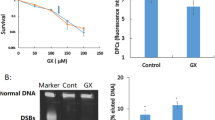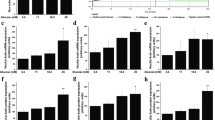Abstract
Substantial evidence suggests a crucial role for glutathione (GSH) and GSH-linked enzymes in protecting against oxidative vascular disorders. However, studies on the chemical inducibility of these antioxidant defenses and their protective effects on oxidant injury in normal human vascular cells are currently lacking. Accordingly, this study was undertaken to investigate the inducibility of GSH, glutathione reductase (GR), glutathione peroxidase (GPx), and glutathione S-transferase (GST) by the chemoprotective agent, 3H-1,2-dithiole-3-thione (D3T) in cultured normal human aortic smooth muscle cells (HASMCs). HASMCs expressed measurable levels/activities of GSH, GR, GPx, and GST. Incubation of HASMCs with low micromolar concentrations of D3T resulted in a marked elevation in total cellular GSH content and GR activity. The protein and mRNA expression of γ-glutamylcysteine ligase (GCL) and GR were also upregulated by D3T. In addition, D3T caused significant increases in mitochondrial GSH content and GR activity. In contrast, neither cellular GPx nor GST activity was altered after D3T treatment. Pretreatment of HASMCs with D3T afforded remarkable protection against reactive oxygen and nitrogen species (ROS/RNS)-mediated cell injury. Depletion of cellular GSH by pretreatment with buthionine sulfoximine (BSO), an inhibitor of GSH biosynthesis led to marked potentiation of the ROS/RNS-induced cell injury. Moreover, co-treatment of HASMCs with BSO was found to completely abolish the D3T-mediated GSH elevation, and remarkably reverse D3T cytoprotection against the ROS/RNS-elicited injury. Taken together, this study demonstrates that both GSH/GCL and GR in normal HASMCs are inducible by D3T, and that upregulation of GSH biosynthesis appears to be the predominant mechanism underlying D3T-mediated cytoprotection against ROS/RNS-elicited injury to human vascular smooth muscle cells.











Similar content being viewed by others
Abbreviations
- BSO:
-
Buthionine sulfoximine
- CDNB:
-
1-Chloro-2,3-dinitrobenzene
- D3T:
-
3H-1,2-dithiole-3-thione
- DCIP:
-
2,6-Dichloroindophenol
- DCF:
-
2,7-Dichlorodihydrofluorescein
- FBS:
-
Fetal bovine serum; GPx, glutathione peroxidase
- GR:
-
Glutathione reductase
- GSH:
-
Reduced glutathione
- GSSG:
-
Oxidized form of glutathione
- GST:
-
Glutathione S-transferase
- MTT:
-
3-[4,5-dimethylthiazol-2-yl]-2,5-diphenyltetrazolium
- PBS:
-
Phosphate buffered saline
- ROS:
-
Reactive oxygen species
- RNS:
-
Reactive nitrogen species
- GCL:
-
γ-Glutamylcysteine ligase
- GCL-C:
-
γ-Glutamylcysteine ligase catalytic subunit
- GCL-M:
-
γ-Glutamylcysteine ligase modulating subunit
- SIN-1:
-
3-Morpholinosydnonimine
- XO:
-
Xanthine oxidase
References
Zweier JL (1988) Measurement of superoxide-derived free radicals in the reperfused heart: evidence for a free radical mechanism of reperfusion injury. J Biol Chem 263:1353–1357
Griendling KK, FitzGerald GA (2003) Oxidative stress and cardiovascular injury: Part II: animal and human studies. Circulation 108:2034–2040
Molavi B, Mehta JL (2004) Oxidative stress in cardiovascular disease: molecular basis of its deleterious effects, its detection, and therapeutic considerations. Curr Opin Cardiol 19:488–493
Yoshida T, Watanabe M, Engelman DT, Engelman RM, Schley JA, Maulik N, Ho YS, Oberley TD, Das DK (1996) Transgenic mice overexpressing glutathione peroxidase are resistant to myocardial ischemia reperfusion injury. J Mol Cell Cardiol 28:1759–1767
Wang P, Chen H, Qin H, Sankarapandi S, Becher MW, Wong PC, Zweier JL (1998) Overexpression of human copper, zinc-superoxide dismutase (SOD1) prevents postischemic injury. Proc Natl Acad Sci USA 95:4556–4560
Chen Z, Siu B, Ho YS, Vincent R, Chua CC, Hamdy RC, Chua BH (1998) Overexpression of MnSOD protects against myocardial ischemia/reperfusion injury in transgenic mice. J Mol Cell Cardiol 30:2281–2289
Liu X, Wei J, Peng DH, Layne MD, Yet SF (2005) Absence of heme oxygenase-1 exacerbates myocardial ischemia/reperfusion injury in diabetic mice. Diabetes 54:778–784
Juan SH, Lee TS, Tseng KW, Liou JY, Shyue SK, Wu KK, Chau LY (2001) Adenovirus-mediated heme oxygenase-1 gene transfer inhibits the development of atherosclerosis in apolipoprotein E-deficient mice. Circulation 104:1519–1525
Yang H, Roberts LJ, Shi MJ, Zhou LC, Ballard BR, Richardson A, Guo ZM (2004) Retardation of atherosclerosis by overexpression of catalase or both Cu/Zn-superoxide dismutase and catalase in mice lacking apolipoprotein E. Circ Res 95:1075–1081
Salvemini D, Wang ZQ, Zweier JL, Samouilov A, Macarthur H, Misko TP, Currie MG, Cuzzocrea S, Sikorski JA, Riley DP (1999) A nonpeptidyl mimic of superoxide dismutase with therapeutic activity in rats. Science 286:304–306
Lefer DJ, Granger N (2000) Oxidative stress and cardiac disease. Am J Med 109:315–323
Bolli R, Becker L, Gross G, Mentzer R, Balshaw D, Lathrop DA (2004) NHLBI Working Group on the Translation of Therapies for Protecting the Heart from Ischemia, myocardial protection at a crossroads: the need for translation into clinical therapy. Circ Res 95:125–134
Lonn E, Bosch J, Yusuf S, Sheridan P, Pogue J, Arnold JM, Ross C, Arnold A, Sleight P, Probstfield J, Dagenais GR (2005) HOPE and HOPE–TOO Trial Investigators, effects of long-term vitamin E supplementation on cardiovascular events and cancer: a randomized controlled trial. JAMA 293:1338–1347
Wu L, Noyan Ashraf MH, Facci M, Wang R, Paterson PG, Ferrie A, Juurlink BH (2004) Dietary approach to attenuate oxidative stress, hypertension, and inflammation in the cardiovascular system. Proc Natl Acad Sci USA 101:7094–7099
Cao Z, Li Y (2004) Potent induction of cellular antioxidants and phase 2 enzymes by resveratrol in cardiomyocytes: protection against oxidative and electrophilic injury. Eur J Pharmacol 489:39–48
Cao Z, Li Y (2004) The chemical inducibility of mouse cardiac antioxidants and phase 2 enzymes in vivo. Biochem Biophys Res Commun 317:1080–1088
Zhu H, Itoh K, Ymamamoto M, Zweier JL, Li Y (2005) Role of Nrf2 signaling in regulation of antioxidants and phase 2 enzymes in cardiac fibroblasts: protection against reactive oxygen and nitrogen species-induced cytotoxicity. FEBS Lett 579:3029–3036
Cao Z, Zhu H, Zhang L, Zhao X, Zweier JL, Li Y (2006) Antioxidants and phase 2 enzymes in cardiomyocytes: chemical inducibility and chemoprotection against oxidant and simulated ischemia-reperfusion injury. Exp Biol Med 231:1351–1364
Cao Z, Li Y (2002) Chemical induction of cellular antioxidants affords marked protection against oxidative injury in vascular smooth muscle cells. Biochem Biophys Res Commun 292:50–57
Cao Z, Hardej D, Trombetta LD, Trush MA, Li Y (2003) Induction of cellular glutathione and glutathione S-transferase by 3H-1,2-dithiole-3-thione in rat aortic smooth muscle A10 cells: protection against acrolein-induced toxicity. Atherosclerosis 166:291–302
Vaziri ND, Wang XQ, Oveisi F, Rad B (2000) Induction of oxidative stress by glutathione depletion causes severe hypertension in normal rats. Hypertension 36:142–146
de Waart FG, Kok FJ, Smilde TJ, Hijmans A, Wollersheim H, Stalenhoef AF (2001) Effect of glutathione S-transferase M1 genotype on progression of atherosclerosis in lifelong male smokers. Atherosclerosis 158:227–231
Blankenberg S, Rupprecht HJ, Bickel C, Torzewski M, Hafner G, Tiret L, Smieja M, Cambien F, Meyer J, Lackner KJ (2003) AtheroGene Investigators, glutathione peroxidase 1 activity and cardiovascular events in patients with coronary artery disease. N Engl J Med 349:1605–1613
Biswas SK (2005) Newby DE, Rahman I, Megson IL, depressed glutathione synthesis precedes oxidative stress and atherogenesis in Apo-E(−/−) mice. Biochem Biophys Res Commun 338:1368–1373
Mayr M, Xu Q (2001) Smooth muscle cell apoptosis in arteriosclerosis. Exp Gerontol 36:969–987
Madamanchi NR, Vendrov A, Runge MS (2005) Oxidative stress and vascular disease. Arterioscler Thromb Vasc Biol 25:29–38
Li Y, Zhu H, Trush MA (1999) Detection of mitochondria-derived reactive oxygen species production by the chemilumigenic probes Lucigenin and luminol. Biochim Biophys Acta 1428:1–12
Wheeler CR, Salzman JA, Elsayed NM, Omaye ST, Korte DW (1990) Automated assays for superoxide dismutase, catalase, glutathione peroxidase, and glutathione reductase activity. Anal Biochem 184:193–199
Flohe L, Gunzler WA (1984) Assays of glutathione peroxidase. Methods Enzymol 105:114–119
Habig WH, Pabst MJ, Jakoby WB (1974) Glutathione S-transferases: the first enzymatic step in mercapturic acid formation. J Biol Chem 249:7130–7139
Kehrer JP (1993) Free radicals as mediators of tissue injury and disease. Crit Rev Toxicol 23:21–48
Sies H, Sharov VS, Klotz LO, Briviba K (1997) Glutathione peroxidase protects against peroxynitrite-mediated oxidations: a new function for selenoproteins as peroxynitrite reductase. J Biol Chem 272:27812–27817
Hayes JD, Flanagan JU, Jowsey IR (2005) Glutathione transferases. Annu Rev Pharmacol Toxicol 45:51–88
Ballinger SW, Patterson C, Yan CN, Doan R, Burow DL, Young CG, Yakes FM, Van Houten B, Ballinger CA, Freeman BA, Runge MS (2000) Hydrogen peroxide- and peroxynitrite-induced mitochondrial DNA damage and dysfunction in vascular endothelial and smooth muscle cells. Circ Res 86:960–966
Anderson ME (1998) Glutathione: an overview of biosynthesis and modulation. Chem-Biol Interact 111–112:1–14
Zhu H, Li Y, Trush MA (1995) Difference in xenobiotic detoxifying activities between bone marrow cells from mice and rats: implications for benzene-induced hematotoxicity. J Toxicol Environ Health 46:183–201
Fernandez-Checa JC, Yi JR, Garcia RC, Ookhtens M, Kaplowitz N (1996) Plasma membrane and mitochondrial transport of hepatic reduced glutathione. Semin Liver Dis 16:147–158
Li Y, Cao Z, Zhu H, Trush MA (2005) Differential roles of 3H-1,2-dithiole-3-thione-induced glutathione, glutathione S-transferase and aldose reductase in protecting against 4-hydroxynonenal toxicity in cultured cardiomyocytes. Arch Biochem Biophys 439:80–90
Acknowledgments
This work was supported in part by NIH grants CA91895 and HL71190 (Y.L.). M.A.T. was supported by NIH grants ES03760, ES03819 and ES08078.
Author information
Authors and Affiliations
Corresponding author
Rights and permissions
About this article
Cite this article
Zhu, H., Cao, Z., Zhang, L. et al. Glutathione and glutathione-linked enzymes in normal human aortic smooth muscle cells: chemical inducibility and protection against reactive oxygen and nitrogen species-induced injury. Mol Cell Biochem 301, 47–59 (2007). https://doi.org/10.1007/s11010-006-9396-z
Received:
Accepted:
Published:
Issue Date:
DOI: https://doi.org/10.1007/s11010-006-9396-z




